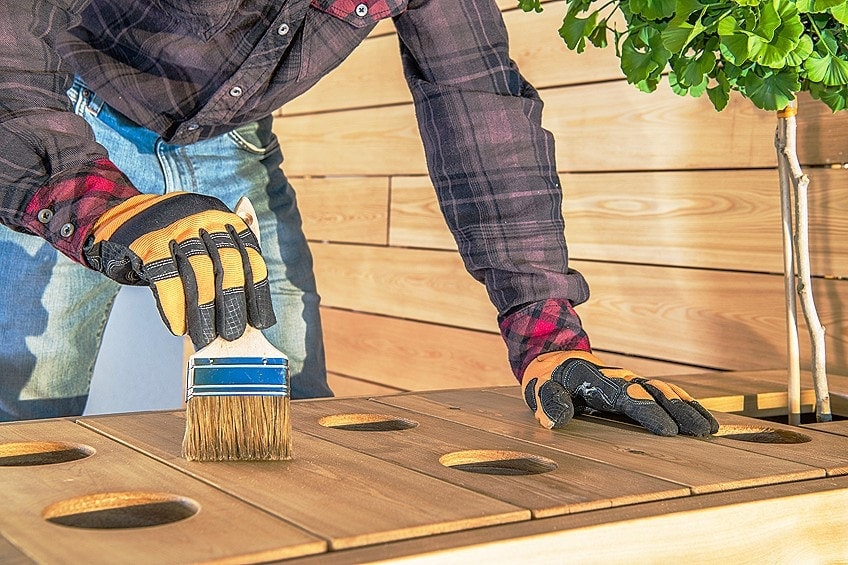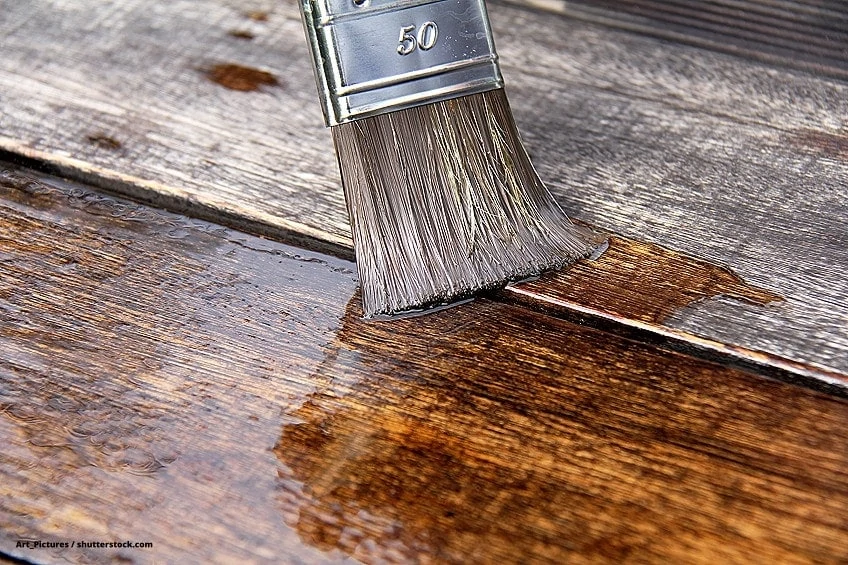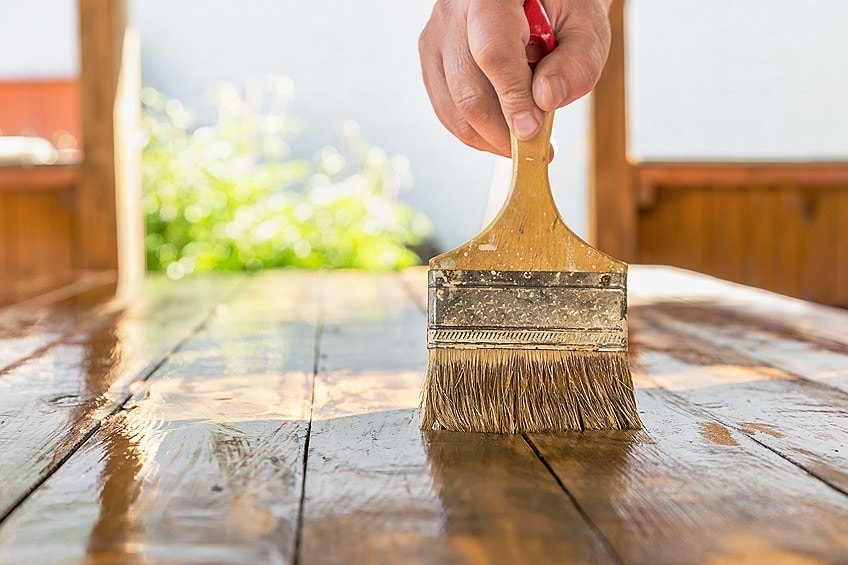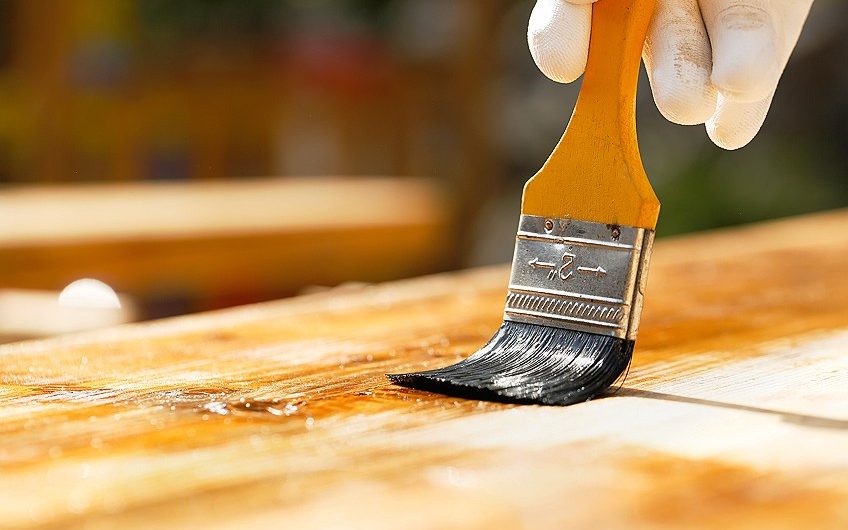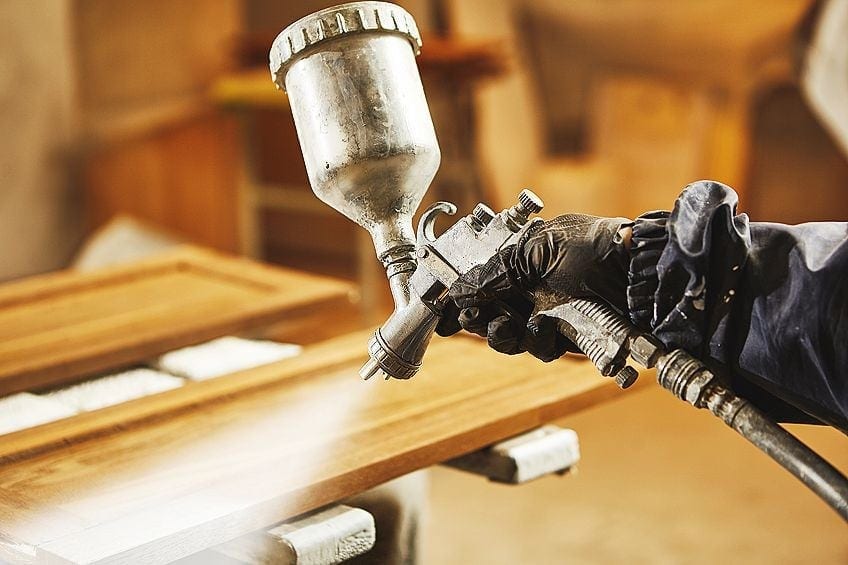Best Exterior Polyurethane – Complete Overview
This post may contain affiliate links. We may earn a small commission from purchases made through them, at no additional cost to you. You help to support resin-expert.com
Polyurethane is your go-to option if you are hoping to give a stunning finish to any of your exterior wooden surfaces while ensuring they remain protected at the same time. What follows is a useful guide that will provide insight into how to utilize polyurethane to protect your exterior woods.
Table of Contents
What is Polyurethane?
Polyurethane is a form of varnish which is very tough and has been formulated as microscopic connections or chains of resin molecules, that as the substance dries, the molecules will bond together tightly. The finish you will achieve is more resilient than other traditional vanishes, particularly in terms of abrasions, solvents, and water.
Certain polyurethanes can give your surface an amber, warm wooden tone as they have oils added to them, but if you prefer to keep your woods light in color, rather select a water-based polyurethane.
Water, Oil, or Both?
Due to VOC emissions which are given off of oil-based polyurethanes, there have been developments into alternative options, ensure you consider the following characteristics before purchasing your polyurethane:
- Water-based: A water-based polyurethane will dry into a crystal-clear coat, and will begin as a milky substance, this makes it a great option if you wish to preserve your wood’s color. Due to the watery nature of the substance, you will be required to use more coats than an oil-based polyurethane, but thankfully the substance dries quickly. Despite being lower in VOCs than that of an oil-based product you will still need to ensure you are working in a well-ventilated area when applying. The water-based product only requires soap and water to clean up and you mustn’t use any ammonia-based products to clean the set coats.
- Oil-based: Oil-based polyurethane can add warmth to your wooden surface, as it is slightly amber in color. You will only be required to apply a few coats, ensuring you a durable, hard surface. It is higher in VOCs than that of any of the water-based options, and it is therefore unfortunately not available in certain areas of the country. You will require mineral spirits in order to clean up any oil-based polyurethane.
- Water-based oil-modified: Similar to that of the oil-based, this form dries to an amber color. It is a fast-drying substance and can be used with any type of wood, also, it has low VOCs levels and you will only require water to clean it up.
Best Exterior Polyurethane
ZAR Exterior Oil-Based Polyurethane
If you are looking for a product to help enhance the natural color of your wooden surfaces, this is a great option. The product provides a slight tint to the wood’s surface and offers a satin finish.
- Fast-drying, oil-based, clear wood polyurethane finish that dries in only 2 hours
- Specifically formulated to protect exterior surfaces that are subjected to direct sunligh
- Ideal for wooden surfaces exposed to extreme, harsh weather
This product provides you with protection for your wooden surfaces, while also adding beauty to your item. Offering you one of the shiniest finishes of the polyurethane products available in the market, superior to any water-based products. This polyurethane provides you with a classy, contemporary finish.
The formula provides you with a durable, tough finish that stands up well to the elements, in particular, that of UV rays. The product is formulated with antioxidants that ensure there is no discoloration to your finished surface.
Pros
- Provides a rich, deep shine
- Includes antioxidants that counteract yellowing
- Provides a satin finish
- Resistant to UV light
- Offers durability and a beautiful finish
Cons
- Has a very short shelf life
- Some users have complained about the thickness being uneven
Oil-Based: RUST-OLEUM Ultimate Oil-Based Spar Urethane
This product is formulated to offer resistance to UV light (from the sun), wooden surfaces can result in discoloration due to the sun’s rays. Through applying this particular product your wooden surfaces will be protected from the damaging effects of the sun’s light.
- Protects outdoor wood surfaces such as furniture, fences, railings, trim and more
- Dries to the touch in 2 hours with coverage up to 190 sq. ft., recoat after 8 hours
- Weather and UV resistant formula protects the surface from graying and sun damage
Once dried this product protects your wooden surfaces from outdoor environmental factors, including the likes of mildew and mold. The formula is also resistant to aspects of moisture, including being water-resistant, this is a result of it being oil-based (oils are hydrophobic).
While this is a wonderful product, there are some negative aspects, such as overtime it does begin to yellow. It can also take a long time to dry in relation to other products available.
Pros
- Resistant to UV rays
- Waterproof and flexible
- Great value for money (best on the list)
- Provides a very shiny finish
- Resistant to mildew and mold
Cons
- Needs 8 hours between each coat, to dry
- Has a chance of changing color over time
Minwax Helmsman Indoor/Outdoor Spar Urethane
This product offers you resistance to UV light, thereby stopping your wooden surface from yellowing, but is not a good option to protect your surfaces from severe external factors. The UV protection stops the wooden surface from peeling.
- Contains UV blockers to reduce the sun's graying and fading effects
- Forms a protective barrier against rain and moisture
- Special oils allow the finish to expand and contract with the wood
This product dries quickly, giving you a very clear finish that shines beautifully and offers a durable surface coating. The fast-drying aspect is not necessarily positive, in particular, if you are tackling a project which requires corrections here and there constantly. If the surface has already begun to dry and then you reapply your brush, can result in you damaging the whole application, which you will then need to sand down.
The consistency of the product is also quite concerning as it is very thin, and will soak into the surface of any porous and softwoods, this means you will need to do many coats to achieve your desired finish.
Pros
- Value for money
- Dries quite fast
- Has UV blockers
- Dries crystal clear
- Can be used for contraction and expansion
Cons
- The consistency might be too thin
- Does not offer the user much working time
Things to Consider When Buying Exterior Polyurethane
Ease of Use
Particular as a beginner you should be looking for a product that is easy to apply, as it means you ideally will be able to tackle the project on your own and will not have to turn to a professional for assistance.
Ultraviolet Resistance
If your finish is clear, therefore allowing the wood grain to show through, this means that damaging sunlight can also get through to the wood. UV blocking is complicated, for a product to reflect the UV light, most formulas have fine ground metallic compounds that while they reflect UV light, are transparent to visible light.
One such component that is used for this is titanium dioxide. Ultraviolet absorbing compounds will absorb the rays of the sun and then release it as heat. Neither option is 100 percent in blocking out UV light completely, to be more effective you would require more blocking components, but having too many will make the substance opaque.
Flexibility
Humidity, temperature, and wind are all elements that cause wood to expand and contract, you need to ensure that the polyurethane used has the correct combination of resin and oils to ensure that it is flexible with the wood. Even though some products, such as Minwax, include specially formulated additives, they may still require a yearly recoating.
When applying a recoating layer, if the existing layer is in a good condition you will only need to clean the surface of any dirt, sand, and grease, by wiping it down with mineral spirits before applying the new coat.
Drying Time
How long the polyurethan will take to dry is a very important factor to take into consideration. If you have a project that has a short time-line, select a product that is fast drying.
Durability
It can be said that the durability of the product is the most important factor to take into consideration. By selecting a durable product you will save money, as you will not be required to refinish the surface as frequently.
How to Apply Polyurethane
Preparing the Wood Surface
To achieve the best result, you will require a clean, smooth surface. Begin by sanding down your wood using at least a 220-grit sandpaper. If your wood is an open-grain variety such as walnut, ash, or oak you can choose to apply a wood grain filler before you begin applying the polyurethane, this will ensure a very smooth finished surface.
Once you have finished sanding down the wood, ensure you clean the surface of any dust before applying each coat of polyurethane, if available use a vacuum, and a tack cloth to remove any dust. Alternatively, you can use a cheesecloth moistened with denatured alcohol (for a water-based polyurethane) or a rag moistened with mineral spirits (for an oil-based polyurethane).
Applying Oil-Based Polyurethane
When using an oil-based polyurethane you may decide to thin it out using naphtha or mineral spirits, but in most cases, this will not be necessary, if you are unsure if this is required, consult the manufacturer’s recommendations. By thinning your oil-based polyurethane you can allow the finish to flow with more ease into any nooks and crannies or any finer details without causing buildup.
When applying oil-based polyurethane you can use a fine-bristled brush (either synthetic bristles or natural) or you can use a foam brush. Try not to use an inexpensive bristle brush as this can result in brush bristle leaving noticeable brush strokes on your surface. If you are looking for an inexpensive option go for a foam brush, these will work well for the majority of flat surfaces. If your project has fine details and molded edges rather use a bristled brush for application.
When applying the polyurethane using a not too thick coat for your finish, to avoid creating bubbles tackle each area with straight, long strokes. Ensure your brush stroke are applied parallel to the grain of the wood. If there are any bubbles that form, they should disappear on their own quickly.
When you have allowed your initial coat to sufficiently dry (consult the manufacturer’s instructions to confirm the required drying time) use 320-grit sandpaper to lightly sand down the surface, ensure you are working parallel to the grain of the wood. Polyurethane sands down with ease, so be careful to not over-sand as it can lead to damaging the overall stain or even the wood underneath. Before you begin applying the next coat ensure you have cleaned the surface sufficiently using the tack cloth or a vacuum.
Continue applying the relevant coats, and repeating the steps accordingly until you achieve the resulting protection you require. Two coats are an absolute minimum for protection, if however, you are covering a surface that received hard wear, such as flooring, or is exposed to occasional moisture, you will be required to apply a minimum of three coats.
With each coat that you apply, you will notice the surface becomes smoother. When you have applied your final coat, you can use #0000 steel wool to rub out the finish offering you a consistent sheen level, and then applying a paste wax which will give you a gorgeous luster.
Applying a Water-Based Polyurethane
Applying water-based polyurethane is a very similar process to that of applying oil-based polyurethane. You will use either a cloth, foam pad, or a fine brush to apply a thin layer of polyurethane, ensure you are applying with the direction of the wood’s grain, and try not to apply too much polyurethane so that you do not raise the grain of the wood.
If you have an oil-based stain on your wooden surface, the water-based polyurethane will not match well, before applying a water-based polyurethane you will need to ‘rough-up’ the stained area of the wood’s surface you can do this using a synthetic steel wool. Doing this you will help stop the polyurethane from beading on the surface of the wood (such as water on a freshly waxed ca).
Once you have applied the first coat, ensure to allow it to dry sufficiently before you begin applying the second coat. You will not be required to sand down the surface between coats (like is necessary for oil-based polyurethane application) but always check the manufacturer’s recommendations.
You should apply at least three coats of water-based polyurethane on areas that receive light use, for more high wear areas such as floors you will require a minimum of four coats to ensure sufficient protection.
Wipe-On and Spray Polyurethane
A great advantage of either spray-on, or wipe-on polyurethane is how thin they are, either option allows you to apply a very thin layer ensuring less overall buildup in the nooks and crannies (just make sure you do not apply too much).
You can use a clean, lint-free rag to apply any wipe-on polyurethanes, while spray-on polyurethanes can be applied just like spray paint. One option that woodworkers use is to apply a thin coat of spray polyurethane as a topcoat over your base coat of ‘conventional’ polyurethane which will give you a smooth finish, free of any brush strokes.
View our Outdoor Polyurethane web story here.
Frequently Asked Questions
Is Polyurethane Toxic?
As polyurethane contains isocyanates (something which scientists consider to be harmful to one’s lungs) it is considered a toxic substance.
Is Polyurethane Ok for Exterior Use?
If your polyurethane is made of the correct formula it is then ideal for exterior use offering a long-lasting clear finish. When purchasing your polyurethane look for one which has addictive for protection from ultraviolet light. Always consult the product’s label and ensure that it states it is for use for exterior surfaces, this is necessary as the dried product will need to flexible to work well with the expanding and contracting of the wood.
Can You Apply Water-Based Polyurethane Over Oil-Based?
Yes, this is possible, but it is important to ensure that you prepare your surface correctly.
Will Polyurethane Make Wood Waterproof?
Unfortunately, polyurethane does not waterproof hardwoods, but it does ensure the wood is water-resistant, thereby protecting the wood. The polyurethane stops water adsorption and repels water, but will not completely waterproof your wood.
Do I Need to Seal Wood Before Applying Polyurethane?
Not all polyurethanes need you to seal the wood before application, but if you are required to filler or seal stain before applying the polyurethane, ensure the sealer you are using is compatible with your vanish, alternatively use a penetrating resin sealer that will finish off your wood completely, though you can then apply polyurethane on top for an even smoother finish.


